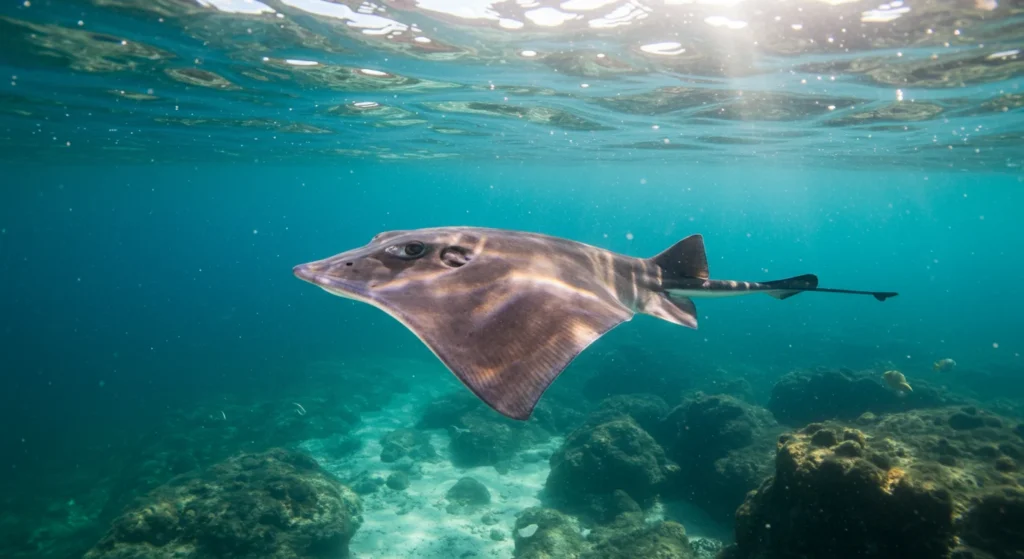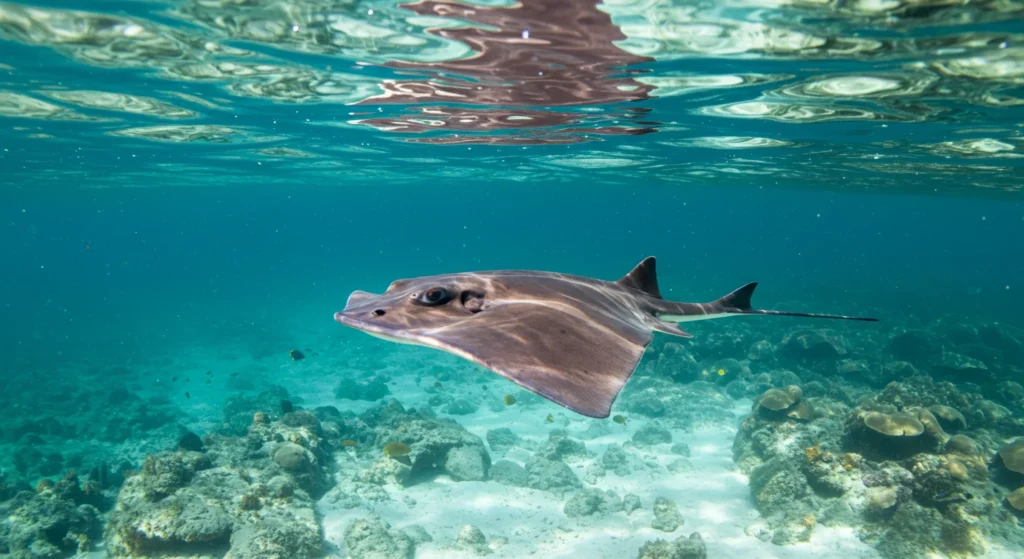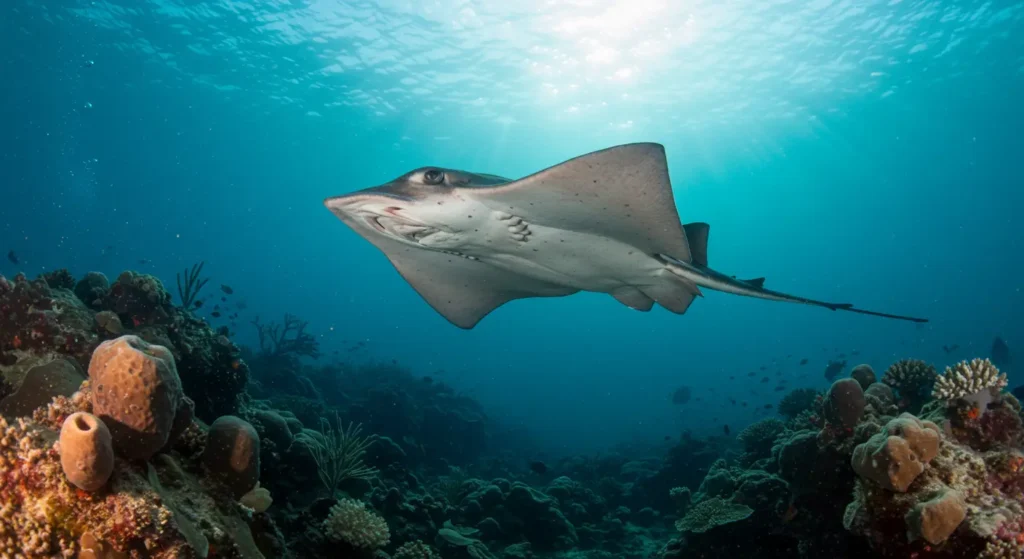Table of Contents
What is Skate Fish?
Skate fish belongs to the family Rajidae and represents one of the most fascinating yet underappreciated seafood options available today. These diamond-shaped flatfish are closely related to sharks and rays, sharing the same cartilaginous skeleton instead of bones. With over 150 species distributed across the world’s oceans, skates have adapted to various marine environments, from shallow coastal waters to deep-sea habitats.
The most distinguishing feature of a skate fish is its unique body structure. Unlike many other fish species, skates have a flattened body with large pectoral fins that extend from the head to the tail, giving them their characteristic wing-like appearance. Their eyes and spiracles (specialized respiratory openings) are positioned on the top of their body, while their mouth and gill slits are located underneath. This evolutionary design allows them to effectively hide on the ocean floor, partially buried in sand or mud, waiting for prey to come within striking distance.
Skates are primarily bottom-dwelling creatures that use specialized sensory organs called ampullae of Lorenzini to detect the electrical fields produced by other organisms. This remarkable adaptation enables them to locate prey even when it’s hidden beneath the seafloor sediment. Their diet typically consists of smaller fish, mollusks, crustaceans, and various invertebrates they find along the ocean bottom.
Unlike many marine species that reproduce by releasing eggs into the water, skates have a more complex reproductive strategy. Female skates produce distinctive rectangular egg cases often called “mermaid’s purses” that protect the developing embryos. These leathery capsules are attached to seaweed or other structures on the seafloor, providing a safe environment for the young skates to develop before hatching as fully formed miniature versions of their parents.

Fresh Skate Fish
When it comes to culinary applications, fresh skate fish offers a unique dining experience that has been appreciated in various cuisines around the world. The edible portions of skate come primarily from their large pectoral “wings,” which contain firm, white meat with a distinctive texture often described as similar to scallops but with a more complex flavor profile.
Selecting high-quality fresh skate requires attention to specific details. First, examine the flesh – it should appear translucent and slightly pinkish with no signs of discoloration. The aroma should be mild and reminiscent of the ocean without any strong ammonia smell, which indicates deterioration. This is particularly important with skate fish as they contain high levels of urea in their tissues, which can quickly break down into ammonia after harvesting if not properly handled.
The freshness window for skate is notably shorter than for many other seafood options. Ideally, skate should be consumed within 24-48 hours of being caught. Professional chefs often recommend purchasing skate that has been kept on ice but not frozen, as freezing can sometimes compromise the delicate texture that makes this fish so prized in gourmet cooking.
When preparing fresh skate wings, proper cleaning and trimming are essential. The cartilage running through the center of each wing provides structure but should be removed before cooking in most recipes. The skin, which has a rough, sandpaper-like texture due to small denticles (tooth-like scales), is typically removed as well, though some traditional preparations may leave it intact for textural contrast.
Cooking techniques for fresh skate fish vary across culinary traditions. In French cuisine, “Raie au Beurre Noir” (skate with black butter sauce) stands as a classic preparation where the wings are poached briefly and then served with a sauce of browned butter, capers, and vinegar. In Mediterranean cooking, skate is often pan-fried with herbs and finished with lemon. Asian preparations might incorporate skate into soups or stews, taking advantage of the meat’s ability to absorb surrounding flavors while maintaining its structural integrity.

Skate vs Stingray
The confusion between skates and stingrays is widespread, even among seafood enthusiasts. While both belong to the class Chondrichthyes (cartilaginous fish) and share similar flat body shapes, there are significant biological differences between these two groups that are worth understanding.
The most notable distinction lies in their defensive mechanisms. Stingrays possess venomous barbed stingers on their tails that can deliver painful and potentially dangerous wounds when threatened. These barbs are not just sharp but also contain venom glands that release toxins upon penetration. In contrast, skates lack these venomous barbs entirely. Instead, skate tails may have thorny projections or small spines for protection, but these structures do not inject venom and generally pose minimal risk to humans.
Another key difference appears in their reproductive strategies. Stingrays are viviparous, meaning they give birth to live young after developing embryos internally, sometimes nourishing them through a structure similar to a placenta. Skates, however, are oviparous – they lay the distinctive rectangular egg cases mentioned earlier, which protect the developing embryos outside the mother’s body until they hatch.
The tail structure offers another visual differentiation point. Stingrays typically have long, whip-like tails that are proportionally thinner compared to their body size. Skates possess shorter, thicker tails that often feature small dorsal fins near the tip, a characteristic absent in most stingray species.
From a culinary perspective, both skates and certain stingray species are consumed in various world cuisines, but skate wings are generally more common in Western fine dining. The meat texture differs subtly – skate tends to have firmer flesh with a more pronounced “stranded” structure that resembles crab meat when cooked, while stingray meat is often slightly softer with a more uniform texture.

Skate vs Ray
While “ray” is sometimes used as a catch-all term that includes skates, there are important distinctions between true rays and skates that extend beyond the stingray comparison discussed above. The term “ray” encompasses several families within the superorder Batoidea, including electric rays, manta rays, and stingrays, while skates belong specifically to the family Rajidae.
One reliable method to distinguish between rays involves examining their pelvic fins. Rays typically have pelvic fins divided into two distinct lobes, with the anterior lobe modified into a finger-like structure. Skates, by comparison, have pelvic fins with a single continuous lobe without this specialized modification.
The spiracles (specialized respiratory openings behind the eyes) tend to be larger in skates compared to most ray species. This adaptation allows skates to draw in oxygenated water while resting on the seafloor, where their gill openings might otherwise be obstructed by sand or mud.
From an ecological perspective, rays often demonstrate more diverse swimming behaviors and habitat preferences. Many ray species actively swim in the water column and may even breach the surface in spectacular displays, as seen with manta rays and eagle rays. Skates are generally more committed to their bottom-dwelling lifestyle, rarely venturing far from the seafloor and employing an undulating swimming motion rather than the “flying” motion characteristic of many ray species.
The distribution patterns also differ somewhat between these groups. While both can be found in oceans worldwide, skates tend to have greater representation in colder, deeper waters, particularly in the Northern Hemisphere. Certain ray groups show stronger preferences for tropical and subtropical environments, especially in coral reef ecosystems.

Skate Fish Common Name
Despite their widespread distribution and culinary value, skate fish are known by various regional common names that can sometimes create confusion among consumers and even within the fishing industry. In North America, species like the winter skate (Leucoraja ocellata) and little skate (Leucoraja erinacea) are sometimes marketed simply as “skate wings” without species distinction. The barndoor skate (Dipturus laevis), one of the largest species found in the Northwest Atlantic, is occasionally referred to as the “barn door” in fishing communities.
In British waters, the thornback ray (Raja clavata) – which is actually a skate despite its common name including “ray” – is sometimes called the “roker” in northeastern England or “maiden ray” in other regions. This inconsistency in naming conventions illustrates how the scientific distinction between skates and rays hasn’t always translated clearly into common usage.
In Asian markets, particularly in Korea and parts of China, certain skate species are known by names that translate roughly to “fermented fish” or “fish with distinctive aroma,” referencing the traditional preservation methods applied to skate meat in these culinary traditions.
The commercial designation of skate fish has become more standardized in recent years due to seafood labeling regulations in many countries. In the United States, the FDA’s Seafood List generally requires skate to be labeled with both the common name “skate” and an indication of the specific species when sold commercially, helping consumers make more informed choices about the seafood they purchase.
Is Skate Fish Good to Eat?
Skate fish offers a distinctive culinary experience that has earned it a place in numerous prestigious cuisines around the world. The edible portion comes primarily from the pectoral fins or “wings,” which contain firm, white meat arranged in tubular structures around cartilaginous rays. When properly prepared, skate presents a unique texture often compared to scallops or even crab meat, with flesh that separates into sweet, succulent strands as it cooks.
The flavor profile of skate is mild yet distinctive – subtly sweet with delicate briny notes that reflect its marine habitat without overwhelming fishiness. This moderate flavor makes it versatile for various culinary applications, readily absorbing accompanying seasonings and sauces while maintaining its character.
In French cuisine, skate has achieved classic status, featured in traditional dishes like “Raie au Beurre Noir” where the wings are poached and served with black butter, capers, and vinegar. This preparation highlights both the elegant texture and the way skate pairs exceptionally well with acidic components that cut through its natural richness.
British coastal communities have long appreciated skate, often preparing it simply breaded and fried or incorporated into fish pies. In Mediterranean traditions, particularly Spanish and Italian cooking, skate might be gently poached with aromatics or grilled with olive oil and herbs.
From a nutritional standpoint, skate provides an excellent protein source with moderate fat content, primarily beneficial omega-3 fatty acids. It contains significant amounts of vitamins B12 and B6, along with minerals like selenium, phosphorus, and potassium. Like many seafood options, it offers these nutrients with relatively few calories compared to other protein sources.
However, skate does present some culinary challenges. As mentioned earlier, it contains high levels of urea that begin breaking down into ammonia shortly after the fish dies. This means extremely fresh skate is crucial for the best eating experience. Skilled seafood purveyors address this issue by properly cleaning and storing skate in ice immediately after catch, and knowledgeable chefs know to soak the wings briefly in acidulated water or milk before cooking to mitigate any developing ammonia notes.
What is Skate Fish Korea?
In Korean cuisine, skate fish holds a particularly fascinating position as the star ingredient in one of the country’s most distinctive traditional dishes: hongeo-hoe. This preparation stands out in global gastronomy for its bold approach to skate preparation and represents an important cultural heritage of Jeolla Province, particularly the South Jeolla region.
Hongeo-hoe involves a specialized fermentation process unique to Korean culinary traditions. Fresh skate, primarily from the species Raja kenojei (or what Koreans call “hongeo”), undergoes controlled fermentation without salt, allowing the naturally high urea content in the skate’s tissues to break down into ammonia. Rather than attempting to minimize this process as in Western cuisine, Korean preparation intentionally develops these complex compounds.
The resulting dish presents an intensely pungent aroma often described as reminiscent of ammonia or, more colorfully, like well-aged cheese or fermented foods. The flavor is equally powerful – sharp, tangy, and distinctly funky with a complex aftertaste that lingers. The texture remains firm yet elastic, with the characteristic stranded structure of skate meat preserved through the fermentation process.
Traditionally, hongeo-hoe is served thinly sliced and accompanied by various condiments that help balance its intense profile: raw garlic, chili pepper paste (gochujang), and kimchi are common pairings. A traditional serving might include “samhap” – a combination of hongeo, steamed pork belly (bossam), and aged kimchi, creating a harmonious balance of flavors despite each component’s individual intensity.
The cultural significance of this dish extends beyond its unique flavor profile. Historically, the fermentation technique developed as a preservation method in coastal regions with abundant skate catches but limited refrigeration. The ammonia that develops naturally in fermented skate actually acts as a preservative, allowing the fish to remain edible for extended periods.
Today, hongeo-hoe represents regional pride for Jeolla Province and has developed something of a reputation as a challenge food even among Koreans. Experiencing this dish has become a gastronomic rite of passage that connects modern diners to traditional preservation techniques and the innovative spirit of Korean ancestors who developed methods to preserve precious protein sources through harsh seasons.
Are Skate Fish Harmless?
When it comes to human interactions, skate fish are generally considered harmless compared to many other marine creatures. Unlike their relatives, the stingrays, skates lack venomous barbs on their tails, eliminating the risk of painful stings that can occur with stingray encounters. This fundamental difference means that swimmers, divers, and waders who encounter skates face minimal danger from these predominantly gentle creatures.
However, this doesn’t mean skates are entirely without defenses. Many species possess small thorns or spines along their backs and tails that can cause minor scratches or punctures if handled improperly. These structures, which vary in size and distribution between species, serve as passive protection rather than active weapons. Fishermen and seafood processors who handle skates regularly are most likely to experience these minor injuries, but they rarely require medical attention beyond basic wound cleaning.
Skates’ defensive behavior primarily involves escape rather than aggression. When threatened, a typical skate response involves quickly burying themselves in sand or swimming away with undulating motions of their pectoral fins. They lack the fight instinct that characterizes more aggressive marine predators and generally prefer avoidance over confrontation.
From an ecological perspective, skates pose no significant threats to healthy marine ecosystems. As mid-level predators, they help maintain balance in benthic communities by controlling populations of invertebrates and smaller fish. Their feeding habits cause minimal disruption to seabed habitats compared to more destructive feeding strategies employed by some marine species.
Do Little Skates Sting?
The little skate (Leucoraja erinacea), a common species found along the Atlantic coast of North America, is frequently encountered by beachgoers, fishermen, and marine researchers. Like all true skates, little skates do not possess venomous stinging mechanisms comparable to those found in stingrays. Their tails lack the barbed, venomous spine that makes stingray encounters potentially dangerous.
Instead, little skates feature rows of small, thornlike structures called dermal denticles along their dorsal surface and tail. These denticles are actually modified scales with a structure similar to teeth (hence the name) that provide protection from predators. While these can feel rough to the touch – comparable to sandpaper – they typically cannot penetrate human skin deeply enough to cause significant injury.
Male little skates develop specialized structures called alar thorns on their pectoral fins, particularly during breeding season. These slightly enlarged thorns help males grip females during mating but pose minimal risk to humans. Similarly, both males and females may have slightly larger thorns along the midline of their backs and tails, but these remain defensive structures rather than offensive weapons.
For the average person encountering a little skate while wading or swimming, the experience should be entirely harmless. If the skate is accidentally stepped on, it’s more likely to attempt a rapid escape than to inflict any kind of injury. Even when handled directly, little skates rarely cause more than minor abrasions – nothing comparable to the painful experience of a stingray encounter.
Marine biologists and educational programs often use little skates in touch tanks precisely because of their generally docile nature and inability to sting, making them excellent representatives for hands-on learning about marine life. Their small size (typically 16-20 inches in length) and relatively calm demeanor when accustomed to handling further contribute to their safety in educational settings.
Can Stingrays Hurt You?
While this article focuses primarily on skate fish, understanding the differences between skates and their close relatives, stingrays, includes addressing the potential dangers posed by stingrays. Unlike skates, stingrays do possess venomous defensive mechanisms that can cause serious injury to humans under certain circumstances.
The primary danger comes from the barbed venomous spine located on the stingray’s tail, sometimes called a “stinger.” This modified dermal denticle has serrated edges and venom glands along its underside. When a stingray feels threatened – typically when accidentally stepped on in shallow water – it can reflexively whip its tail upward, driving this barb into the perceived threat.
A stingray injury typically causes immediate intense pain, described by victims as comparable to being cut and burned simultaneously. The wound itself may bleed significantly, and the surrounding tissue often becomes inflamed and discolored as the venom takes effect. Secondary symptoms can include nausea, vomiting, diarrhea, muscle cramps, and in rare but severe cases, more serious complications like difficulty breathing or irregular heartbeat.
The most infamous stingray-related fatality involved Australian wildlife expert Steve Irwin in 2006, who died when a stingray’s barb pierced his chest, causing a cardiac trauma. It’s important to note that such fatal incidents are extremely rare – most stingray injuries affect the lower extremities and, while painful, are not life-threatening with proper treatment.
To minimize risk when in areas where stingrays might be present, marine safety experts recommend the “stingray shuffle” – sliding one’s feet along the seafloor rather than taking steps, which gives stingrays (which often lie partially buried in sand) warning and opportunity to swim away rather than being stepped on directly.
First aid for stingray injuries involves flushing the wound thoroughly with clean water to remove fragments of the barb and venom, followed by immersion in hot water (as hot as can be tolerated without burning) for 30-90 minutes. The heat helps denature the protein-based venom, reducing its effects. Medical attention should be sought for proper wound cleaning, possible tetanus prophylaxis, and assessment for retained barb fragments.
Are Skate Fish Dangerous?
When considering the potential dangers associated with marine life, skate fish rank among the least threatening creatures one might encounter in ocean environments. As established throughout this article, true skates lack the venomous barbs that make some of their relatives potentially hazardous to humans. This fundamental difference places skates firmly in the category of marine creatures that pose minimal risk to people.
The physical characteristics that might potentially cause harm are limited to the small thorns or denticles that cover portions of their bodies, particularly along the midline of the back and tail. These structures can cause minor abrasions if a person handles a skate roughly or without appropriate protection, but such injuries rarely require more than basic first aid. Commercial fishermen who regularly handle large quantities of skates might occasionally experience cuts from these thorns, but these represent occupational hazards rather than inherent dangers to the general public.
From a behavioral perspective, skates display no aggressive tendencies toward humans. They are naturally shy, typically retreating when approached by divers or swimmers. Even when cornered or captured, their defensive response involves attempts to escape rather than to attack. The mouth of a skate, located on the underside of the body, is adapted for feeding on bottom-dwelling creatures and lacks the capacity to inflict significant bites on humans.
In controlled environments like aquarium touch tanks, skates often demonstrate remarkable tolerance for human interaction. Many species become accustomed to handling and may even approach visitors, associating them with feeding opportunities. This docility makes them popular additions to educational programs where direct contact with marine life enhances the learning experience.
From an ecological standpoint, skates contribute positively to marine ecosystems as mid-level predators helping to control populations of various invertebrates and maintaining healthy benthic communities. They pose no threat to swimmers, divers, or other recreational ocean users, making them peaceable neighbors in shared marine environments.
Is It Safe to Swim with Stingrays?
Although distinct from the skate fish that forms our primary focus, the question of swimming with stingrays frequently arises in discussions about flat cartilaginous fish. Under certain circumstances and with proper precautions, swimming with stingrays can be a relatively safe activity that provides unique opportunities to observe these graceful creatures.
Many tourist destinations in tropical regions offer guided stingray encounters in shallow, sandy areas where certain stingray species naturally congregate. These experiences typically involve professional supervision and take place in controlled settings where the stingrays have become habituated to human presence, often associated with feeding opportunities. In such environments, stingrays may display remarkably calm behavior, allowing close observation and even gentle touching of their smooth dorsal surfaces.
The safety of these interactions depends largely on following established protocols. Participants are typically instructed to shuffle their feet when moving through sandy-bottomed areas where stingrays might be resting, avoiding the risk of accidentally stepping directly on a partially buried ray. Guides usually demonstrate the proper way to interact with the animals – touching only the central portion of their “wings” and avoiding sensitive areas near the eyes, mouth, and especially the tail.
It’s worth noting that many commercial stingray encounter operations in tourism hotspots involve stingrays whose barbs have been trimmed (similar to clipping a fingernail, not removing the entire structure) as an additional safety measure, though this practice raises ethical considerations about wildlife modification for human convenience.
Wild stingray encounters require greater caution. Swimmers should maintain appropriate distance and avoid attempting to touch wild rays, which may perceive close approaches as threatening. Most stingray injuries occur when the animals are stepped on accidentally, triggering their defensive reflex to protect themselves with their venomous tail barb.
Is Stingray Halal?
Within Islamic dietary laws, the permissibility of consuming stingray involves nuanced theological considerations that also relate to skates, given their biological similarities. Islamic scholars have offered varying interpretations regarding whether cartilaginous fish like stingrays and skates qualify as halal (permissible) for consumption by Muslims.
How Big Was the Stingray That Killed Steve Irwin?
The fatal stingray encounter that claimed the life of renowned wildlife expert Steve Irwin in 2006 involved a short-tail stingray (Bathytoshia brevicaudata), sometimes called a smooth stingray. According to witnesses and reports from the incident, this particular specimen was estimated to be approximately 6.5 feet (2 meters) wide from wing tip to wing tip, representing a large but not exceptional example of this species, which can reach widths of up to 14 feet (4.3 meters).
This species is known for having one of the longest stinging barbs among all stingrays, potentially reaching lengths of up to 14 inches (35 cm). The size of the specific barb involved in the incident was not officially measured, but experts believe it was likely substantial, given the severity of the injury inflicted.
The tragic incident occurred while Irwin was filming a documentary called “Ocean’s Deadliest” in shallow waters off Queensland, Australia. According to cameraman Justin Lyons, who witnessed the event, Irwin was swimming above the stingray when it perceived a threat and deployed its defensive mechanism, striking upward with its tail multiple times. One of these strikes penetrated Irwin’s chest, causing a wound that damaged his heart and resulted in his death within minutes despite immediate first aid attempts.
Wildlife experts emphasize that this type of fatal interaction is extremely rare. Stingrays typically employ their venomous barbs only defensively, and the vast majority of stingray injuries affect the lower extremities, not the chest or vital organs. The unique circumstances of Irwin’s close proximity while swimming directly above the animal, combined with the ray’s perception of being cornered, created an unusually dangerous situation.
Conclusion
Skate fish represent a fascinating group of marine creatures that offer significant culinary value while posing minimal risk to humans compared to some of their cartilaginous relatives. Their unique anatomy, reproductive strategies, and ecological roles make them worthy subjects of both scientific study and gastronomic appreciation.
The distinctions between skates and their close relatives – particularly stingrays – extend beyond academic classification to practical considerations involving human interactions, from fishing practices to beach safety. Understanding these differences can enhance both safety and appreciation when encountering these remarkable flat fish in various contexts.
Across different cultures, skates have found their place in culinary traditions ranging from the refined French preparation of skate wing with brown butter to the intensely fermented hongeo of Korean cuisine. This culinary versatility speaks to the adaptability of human taste and the ingenuity of food preservation techniques developed across generations.
As with many marine species, several skate populations face challenges from fishing pressure and habitat disruption. Sustainable fishing practices and informed consumer choices can help ensure these ancient and remarkable creatures continue their important role in marine ecosystems for generations to come. Whether encountered on a dinner plate or observed in their natural habitat, skate fish deserve recognition for their distinctive characteristics and contributions to marine biodiversity.








